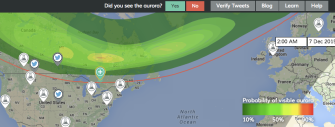The Northern Lights are Creeping Farther South

The allure of travel — it’s a fundamentally human drive. Perhaps we dream about seeing the Seven Wonders of the Ancient World, or visiting some other famous natural wonder. Maybe we’ve even wistfully questioned if we could someday go to see the Northern Lights, one of Earth’s most well-known natural phenomena. Too bad our jobs and lives keep us bounded from traveling around willy-nilly to take in the sights.
Fortunately, the natural world is ever-changing and full of surprises. Now the Northern Lights, also known as Aurora borealis, are headed south. Once visible from only the most northern locations, the Northern Lights are being spotted in many parts of the lower U.S. states, as well as in central Europe.

Aurorasaurus maps aurora sightings.
So it could be time to step outdoors and see what’s up in the sky. You might even try using the site Aurorasaurus to figure out if you will be able to view the lights from where you live. The site uses self-reported data to determine where exactly the Northern Lights can be seen at any given time. It even shares Twitter updates that mention sightings of the glowing plasma phenomena.
It appears as though the Northeastern part of the U.S. has a much better chance of seeing the Northern Lights for now. Maybe some of these new viewers will document the aurora and inspire others to trek out to try and catch them for themselves. Exact locations of the Northern Lights’ visibility is variable however, and not easy to predict.
The changing visibility of the Northern Lights probably has to do with the fact that the Earth’s magnetic field is weakening (though scientists say we have nothing to worry about for quite a while). The magnetic field impacts solar wind, which in turn causes changes in the Aurora borealis, so that might be the reason its patterns are shifting. Scientists and viewers are waiting to see where this magical happening moves to next.
—
Stefani is a writer and urban planner based in Oakland, CA. She holds a master’s in City and Regional Planning from UC Berkeley and a bachelor’s in Human Biology from Stanford University. In her free time she is often found reading diverse literature, writing stories, or enjoying the outdoors. Follow her on Twitter:@stefanicox





